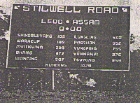My Sipura SPA-2000 arrived today. With some fiddling, greatly aided by this helpful article by Dorian Gray, I was able to get the Sipura talking to my Digium Wildcard X100P.
I’ve only just started configuring Asterisk, but I’ve already got the this all hooked up to (902) 892-2556, and it’s accepting my voicemail and emailing me my messages as audio file attachments (interestingly, this was the easiest part of the system to set up).
All of this is something of a relief, as I spent so many frustrating hours trying to get USB and the Digium S100U to play happily — I never succeeded — that this was my first real opportunity to be impressed by Asterisk. And it is impressive.
More information, and a detailed step-by-step, coming soon.
I’ve noticed that in this U.S. primary campaign, all television and radio advertising by the candidates contains a section where the candidate says “I’m blahblahblah and I’ve approved this message.”
Apparently this is required by law, as the result of the Bipartisan Campaign Reform Act of 2002 [PDF] that states, in s.311 (3) (d) (1) (a):
Any communication described in paragraph (1) or (2) of subsection (a) which is transmitted through radio shall include, in addition to the requirements of that paragraph, an audio statement by the candidate that identifies the candidate and states that the candidate has approved the communication.
And in s.311 (3) (d) (1) (b):
Any communication described in paragraph (1) or (2) of subsection (a) which is transmitted through television shall include, in addition to the requirements of that paragraph, a statement that identifies the candidate and states that the candidate has approved the communication.
Thanks to IsleAsk for research assistance.
I think Catherine and I have had about two dozen conversations about the moon. She would claim it was five dozen.
They all go something like this:
Peter: Hey, look, the moon is really bright tonight, and it was really dark last week.
Catherine: Yes, that’s the way the moon is.
Peter: That’s amazing.
Catherine: Yes, it is.
Despite working every day on a project for which the moon is, perhaps more than for any other project save the moon landing, front and centre, I’m surprisingly amazed (read “dense”) when it comes to the moon.
For some reason, I managed to skip any sort of formal training in the ways of the moon. I vaguely remember some discussion of the tides in Grade 11 Geography. But none of my classrooms had those neato mobiles that cleverly illustrate the moon revolving around the earth revolving around the sun.
So I have decided that this is the year I will come to understand the moon.
First project towards this goal was the creation of the Moon Phase RSS Feed, which, because it gives me a daily whack on the side of the head about the moon, has proved invaluable (if you can’t RSS, you can look here for similar effect).
Next, I’m going to have to get all these nested revolvings understood.
Of course that leaves the wonder of the sun still hanging: Oliver and I sat on the big orange chair in the living room this morning and the sun was aligned so that it was shining right through the piano window at us. It was surprisingly warm. Yet it’s winter. Go figure.
The Yahoo! Around the World Travelogues section is a good place to start if you’re interested in web information from circumnavigators.
Here’s the link that lets you make a donation to the Canadian Red Cross in support of their work with the earthquake in Iran (and here are the American and British
counterparts).
And here’s a useful statement from the British Red Cross titled Why we ask for money, not gifts:
It is often thought that a ‘free’ donation of clothes, medicine, or tinned food helps the victims of disasters, but with cash the British Red Cross can help more people, more cheaply, and more efficiently.
As part of the world’s largest emergency response network, the British Red Cross is ready to meet crisis needs anywhere, at any time. That means having the right equipment, personnel, aid and technical know-how to respond to anything from a major earthquake to the outbreak of war.
Cash is the lifeblood of rapid response. It can be instantly transferred and converted into whatever is most needed, anywhere in the world. Cash not only allows us to use our strong purchasing power to benefit the maximum number of people; it also allows us to adjust our response very rapidly to changing needs and priorities in the affected country.
 One of the items mentioned in First Overland, the story of the Cambridge-Oxford expedition to drive from London to Singapore that I just finished reading, is that the so-called Burma Road (also known as the Stillwell Road, after General Joseph Stillwell), which was built during World War II to connect Ledo in Assam, India, to Kunming, China, cost the U.S.A. $137 million to build.
One of the items mentioned in First Overland, the story of the Cambridge-Oxford expedition to drive from London to Singapore that I just finished reading, is that the so-called Burma Road (also known as the Stillwell Road, after General Joseph Stillwell), which was built during World War II to connect Ledo in Assam, India, to Kunming, China, cost the U.S.A. $137 million to build.
I was curious to know how much this would be “in today’s dollars,” which led to a further curiousity about how “in today’s dollars” amounts are calculated.
I sent this question in to the IsleAsk service and received a very helpful reply from Brenda Brady at the Holland College Library with some pointers to relevant websites:
- Current Value of Old Money from the University of Exeter.
- How Much Is That? from the Economic History Association.
- The Value of Money from Suburban Library System in Burr Ridge, IL.
What one learns from these and other websites is that, to quote Brenda, “determining the relative change in the value of money is not as simple as it looks, and can depend on context, changing technologies, changes in supply and demand, etc.”
That said, using the calculator on the How Much Is That? site, the $137 million figure comes out to anywhere from $1.5 billion (using the Consumer Price Index) to $2.3 billion (using the unskilled wage) to $4.2 billion (using the Gross Domestic Product per capita).
Calculated using any of these methods, it’s still one heck of a lot of money for a 1,079 mile road: even in 1942 dollars it was more than $125,000 per mile. Although, of course, not as much as our Confederation Bridge. But they had to go over water.
If you haven’t tried IsleAsk, I would encourage you to do so: it’s an easy way to get high quality reference information, from local sources, at no cost.
The sole piece of culinary expertise passed through the generations from my grandfather was how to make proper potato pancakes. My father taught us. I will teach Oliver.
Unfortunately Catherine dismisses all potato pancakes as merely “potatoes, salt and fat,” and refuses to even consider enjoying them, which is going to interfere with the evolutionary pass-down scheme.
What’s worse, you can’t really make good potato pancakes without an electric frying pan (at least in our tradition), and having lacked an electric frying pan for at least a decade, there’s been a significant turn-down in my potato pancake consumption recently.
So today, what with it being the heart of the holiday season and the taste of Rukavina family potato pancakes of yore dancing in my head, I took Oliver up to Smitty’s to have their version thereof.
Unfortunately, like everything else on the menu at Smitty’s, they were bland, dry, and tasteless except for the salt (sometimes I think a giant tanker pulls up to the back door at Smitty’s once a year and drops off a load of generic “breakfast food glop” from which they then concoct all of their food, simply varying the amount of salt and food colouring to approximate each dish).
So rather than sizzling into my body with a rush of holiday glee, the Smitty’s pancakes hit me lit a ton of, well, breakfast food glop.
Sigh.
I may have no choice but to arrange for Catherine to go on some extended errand, and to then secretly bring a proper electric frying pan into the house, along with a sausage grinder (the other required apparatus, used to properly grind the potatoes), and cook up a bunch for Oliver and I.
Merry Christmas, Papa Dan, wherever you are.
I’m still looking for information on Hermann Kleefisch’s trip around the world. He set off from Prince Edward Island in July in a VW microbus.
Bob Likely passed along a possible email address this morning, and I’ve written to see if I can get an update.
If anyone else has any news, I’d welcome it.
Starting on November 1, 2003, a convoy of left California for a longitudinal circumnavigation by Land Rover. The trip is in support of The Parkinson’s Institute.
As I write this, they’re in Ecuador. They’ll head through South America, then around to Australia, Singapore, Malaysia, Thailand, Cambodia, Vietman, Laos, Myanmar, India, Sri Lanka, China, Kyrgyzstan, Kazakhstan, Russia, Alaska, Canada, and then back into the continental US with a finish in July, 2004 in California.
The expedition has a Take Me With You! program where they invite “members of the media, sponsors, professional travel writers, photographers,filmmakers, and celebrities” to travel with them for one to two week periods.
 I am
I am